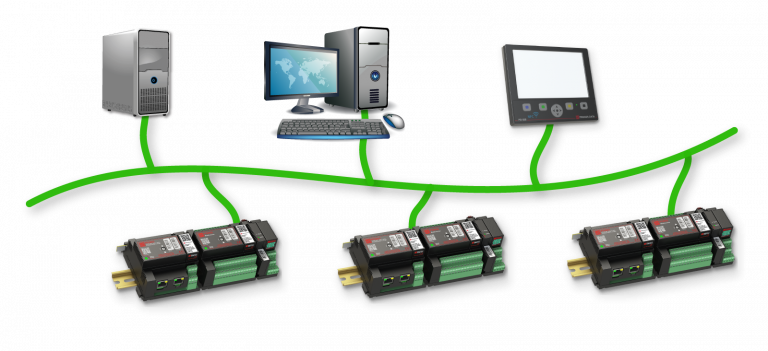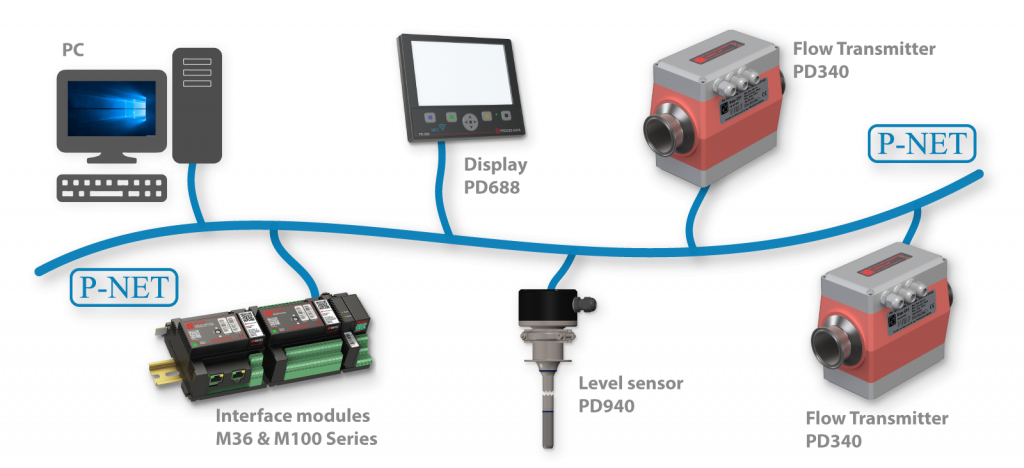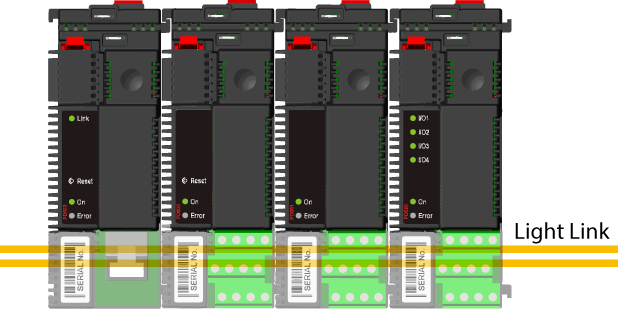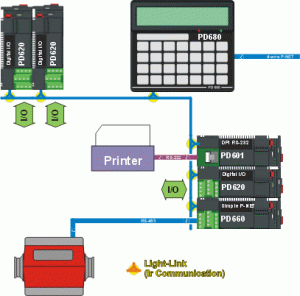P-NET communication can take place on many different media types, such as Ethernet, RS485, Light-Link, RS232, WiFi, Internet, and GPRS.
P-NET Ethernet
Ethernet has its advantage at the large bandwidth.
P-NET on Ethernet, the P-NET protocol and Ethernet is used as a transport medium for P-NET packages.
PROCES-DATA recommends using only Switches to form the network. An Ethernet switch ensures that communication packets are only sent to the relevant members on the network. For PC Monitoring this communication form is highly suitable and gives any PC connected to the LAN network a simple access to the process or production facility.
Due to the wide acceptance of Ethernet in the PC industry, network components are available from many suppliers in industrial or office designs and with various features. If the Ethernet has no connection to the Internet or other external networks, the configuration is as simple as setting up a normal P-NET.
– Ethernet – 10 BASE-T or 10 BASE-T / 100 BASE-TX
– Bus structure: Physical star connection (through a switch)
– Bus length: Max. 100 meters
– Up to 125 P-NET IP nodes per IP network segment
– Number of confirmed transmissions/s: 1000 @ 10 mbit/s

P-NET RS485
The electrical specification of P-NET is based on the RS485 standard using a shielded twisted pair cable.
This allows a cable length of up to 1200 m without repeaters. P-NET interfaces are galvanically isolated, and up to 125 devices per bus segment can be connected, due to a special clamp circuit, and again without the use of repeaters.
P-NET is a multi-master bus, which can accept up to 32 masters per bus segment. All communication is based on the principle, where a Master sends a request, and the addressed Slave returns an immediate response.
– RS485 standard using a Shielded Twisted pair
– Bus structure: A physical ring without termination or bus topology
– Each bus segment up to 1200 meters
– Multi-master bus, which supports a Multi-net structure
– Up to 125 devices per bus segment and up to 32 Masters per bus segment
– Standard baudrate: 76.8 kbit/s, Tripple speed baudrate: 230.4 kbit/s (special conditions apply)
– Number of confirmed transmissions/s: 300/900 (request and response)

P-NET Light-Link
P-NET Light-Link provides an optical communication link for P-NET.
P-NET Light-Link is the means of communication between 800/600 series modules.
The common Tx and Rx optical paths are automatically connected between terminal modules during placement, and an optical “spur” connection is made available to any electronics modules that are fitted. In copper wiring terms, using Light-Link is equivalent to daisy-chaining a 3-wire connection between each module, but without having to perform the time consuming and bulky physical connection. Such an optical medium obviously provides galvanic isolation, but since light signals are received, amplified and transmitted at each node junction (acting as a repeater), this ensures optimal Light-Link signal anywhere in a cluster of modules, no matter the number of modules.
– Light-Link provides an optical communication link for P-NET
– Light-Link provides galvanic isolation between each member in a communication chain
– Multi-master bus, which supports a Multi-net structure
– Fibre bus length: Max. 0.5 metre
– Up to 125 nodes per bus segment, up to 32 Masters per bus segment
– Standard baudrate: 76.8 kbit/s, Tripple speed baudrate: 230.4 kbit/s*
– Number of confirmed transmissions/s: 300/900 (request and response)
* In P-NET networks, where all devices are interconnected exclusively by Light-Link, communication speeds of up to 230.4 kbit/s are permitted. This is 3 times the normal P-NET speed when compared with using standard RS485 connections.

P-NET RS232
P-NET RS232 is to be considered as a point-to-point connection between two network nodes. Can be used for serial communication between a PC and P-NET controller with a serial interface. Can also be used in connection with P-NET communication via modem, serial printer connection, barcode reader or similar.
The RS232 interface is often used as printer interface.
– RS232 standard
– Bus structure: Point-to-point connection
– P-NET RS232 / RS232: Baudrate: 4.8 kbit/s – 115.2 kbit/s
– Bus length: max. 12 meters


Cabling and electrical specifications
| P-NET Ethernet | P-NET RS485 | P-NET Light-Link | P-NET RS232 | |
|---|---|---|---|---|
| Electrical standard | Ethernet | RS485 | IR | RS232 |
| Topology | Star topology Ethernet switch must be used | P-NET ring topology: Physical ring without termination P-NET bus topology: Bus with termination | Multimaster bus Multinet supported | Point to Point connection |
| Network media | Unshielded Twisted-Pair Cable (Cat 5. UTP) | Twisted-Pair Cable with shield (STP) Characteristic impedance 100-120 ohm IBM Twinax, having a characteristic of 105 ohms and 51 pF per metre | Fiber-optic Cable Optical medium provides galvanic isolation. | Twisted-Pair Cable with shield (Cat 5. STP) |
| Cable type | Cat 5. UTP | P-NET Cable | Type: Plastic Optical Fibre, 1000 µm, Agilent order no. HFBRRUS 100 (100 m) | Cat 5. STP |
| Bus length | Max. 100 m. | Max. 1200 m (EIA RS485) without the use of repeater. P-NET installed as bus topology can have a maximum length of 600 metres Triple Speed: The maximum RS485 cable length is 50 meters, and P-NET bus topology must be used | Fibre cable max. 0.5 m. | Max. 12 m. |
| Max number of nodes per bus segment | 125 nodes | Up to 125 nodes Up to 32 masters | Up to 125 nodes Up to 32 masters | 2 nodes Point to Point |
| Communication speed | 10/100 Mbit/s 1000 confirmed transmissions per second | 76.8 kbit/s/230.4 kbit/s (Triple Speed) 300/900 confirmed transmissions per second | 76.8 kbit/s / 230.4 kbit/s (Triple Speed) 300/900 confirmed transmissions per second | 4.8 - 115.2 kbit/s |
| Determinism | Yes, Ethernet switch must be used | 390 µs | 390 µs - 130 µs | |
| Accessories | Holding wedges, Plastic Optical fibre cable, fibre cutter | |||
| Bending radius | > 30 mm |





